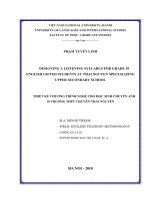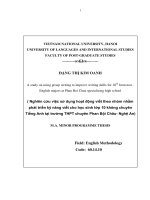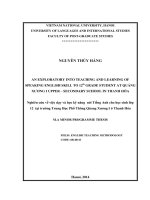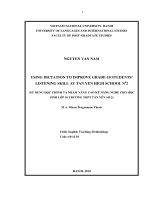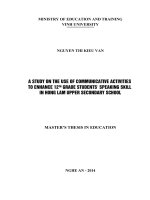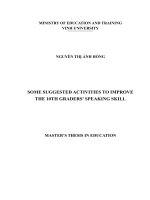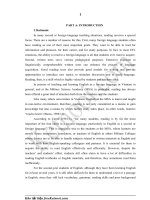SOME SUGGESTED SOLUTIONS TO IMPROVE GRADE 12 STUDENTS SPEAKING SKILL IN ENGLISH CLASSES AT NONG CONG 3 UPPER SECONDARY SCHOOL
Bạn đang xem bản rút gọn của tài liệu. Xem và tải ngay bản đầy đủ của tài liệu tại đây (5.1 MB, 39 trang )
TABLE
OF
CONTENTS
TABLE OF CONTENTS
PART 1: REASONS FOR TOPIC CHOICE
PART 2: CONTENT
I. THEORETICAL BASIS
1. Students’ psychological characteristics in learning Englis
2. Importance in stimulating participation of students in
English lesson.
3. Speaking skill
II. THE REAL STATE OF AFFAIRS
1. Researching method.
2. Researching questions.
3. Results of the convey.
III. SOLUTIONS
1. Solutions to big classes
2. Pair work
3. Group work
4. Further practice
5. Class activities and games
5.1. Warm-up activities and games.
5.2. Class activities
5.3. Pair work
5.4. Group work
6. Suggested Activities and Games in speaking lessons of
PAGES
1
2
3
3
4
4
5
5
5
6
6
6
7
7
8
8
8
13
14
16
22
43
English Textbook 12
PART 3: CONCLUSION
REFERENCES
44
INITIATIVE: “SOME SUGGESTED SOLUTIONS TO IMPROVE
GRADE 12 STUDENTS' SPEAKING SKILL IN ENGLISH CLASSES AT
NONG CONG 3 UPPER SECONDARY SCHOOL”
PART 1: REASONS FOR TOPIC CHOICE
In the world of the integration and development with the multilateral
relations and information explosion, English remains an important role in
comprehensive development for each student. However, in fact, I realize my
students find it very difficult to express their ideas in English and they even do
not know how to keep the conversation going on. They are usually stressed and
1
passive when being asked to participate in speaking activities. More importantly,
the topics chosen are quite broad and the way teachers develop them is not very
interesting. Some topics are beyond students’ enjoyment. And some require a
deep common knowledge which students usually lack. If students have no idea
what to say, they may lose confidence and feel uncomfortable and make
mistakes. Consequently, teaching and learning in the speaking lessons are boring
and ineffective. Therefore, it is essential that we carry out better methods in
order that students have certain abilities of English communication. Nowadays,
in the process of teaching method improvement, the main purpose is to form and
develop the knowledge and skills in using English. English 12 gets in close
contact with distinct skills: listening, speaking, and reading. To practice these
skills, each student has to work diligently with his/her partners. Consequently,
they can speak English more fluently. With the aim at developing speaking skill,
I am going to present the subject: “SOME SUGGESTED SOLUTIONS TO
IMPROVE GRADE 12 STUDENTS’ SPEAKING SKILL IN ENGLISH
CLASSES AT NONG CONG 3 UPPER SECONDARY SCHOOL.”
This research is to help students simply communicate with the classmates.
It also helps teachers build the content of a teaching lesson. As a result, students
will be effectively attracted to English lessons.
PART 2: CONTENT
I. THEORETICAL BASIS
1. Students’ psychological characteristics in learning English.
Students own age characteristics and innate skills which help them in
learning language process. Teachers must fully understand and take full
advantages of them effectively. These specific characteristics are: They learn a
foreign language naturally as they learn their mother tongue. They learn it
through encouragement, which depends on each teacher’s methods. If they are
effectively motivated, they will perform better and more enthusiastically.
Besides, they learn through their listening and repeating, through cooperation
2
and reciprocation in reliable atmosphere; and through interesting activities from
which they gain their aims.
One of the things that makes teaching a source of endless fascination is the
fact that no two classes are ever the same. There always exists the complex
interpersonal chemistry between teacher and students and between student and
student. In any given classroom, the factors such as position attitudes and
individuals’ personalities will be in constant interaction creating a dynamic,
unstable environment that can either facilitate the learning process or seriously
impair it. The role of expectations of both teachers and learners will be
conditioned by individual personality factors such as introversion, cognitive
style, prior learning and teaching experiences, and cultural factors.
Real-life observation also tells us that even if language learners can be
shown to be following a common developmental route, they differ greatly in
degree of ultimate success which they achieve. As a teacher, one should be
aware that learners differ in ways that careful thought when making decisions
about what to be taught and how to teach. Social psychologists have argued
consistently that differences in learning outcomes must be due to individual
differences between learners, and many proposals have been made concerning
the characteristics which supposedly cause these differences.
Gardner and MacIntyre (1992, 1993) divided what they saw as the most
important learners’ traits into two groups, the cognitive and affective. Cognitive
factors include students’ intelligence, language aptitude and language learning
strategies. Most discussions have limited affective factors to personality
characteristics, language attitudes, motivation and emotional responses to the
language learning process or language anxiety.
Krashen (1985) has suggested the notion of the affective filter. This is a
representation of the way in which affective factors such as attitudes, anxiety,
competitiveness and other emotional responses can help or hinder language
learning. A learner who has generally negative attitudes towards learning. A
learner who has generally negative attitudes towards learning English will have
a high effective filter and the task for the teacher will be sustantial. The precise
functioning of this filter highlights the role of the teacher in creating beneficial
conditions for language learning.
The degree to which any of the factors discussed will become significant
in a particular learning and teaching situation will depend partly on the reasons
3
why learners are learning English. Any individual may be influenced by a
variety of motivations which will affect such things as anxiety, attitudes or
willingness to try new learning strategies.
In short, there exist individual differences among learners and these
differences play a significant role in language learning. For a teacher, the
challenge must be how to enable each learner according to his or her individual
characteristics and cultural background.
2. Importance in stimulating participation of students in English
lesson.
Students’ participation is very necessary for learning process to occur.
Lack of participation will have negative influence on all the learning process.
Through interacion in the target language students learn to communicate. Hence,
speaking skill is quite important.
3. Speaking skill
Speaking is the productive skill in the oral mode. It, like the other skills, is
more complicated than it seems at first and involves more than just pronouncing
words. There are three kinds of speaking situations in which we find ourselves:
- Interactive.
- Partially interactive.
- Non-interactive.
Interactive speaking situation include face-to-face conversations and
telephone calls, in which we have chance to ask for clarification, repetition or or
slower speech from our conversation partner. Some speaking situations are
partially interactive, such as when giving a speech to a live audience, where the
convention is that the audience does not interrupt the speech. The speaker
nevertheless can see the audience and judge from the expressions on their faces
and body language whether or not he or she is being understood.
Some few speaking situations maybe totally non-interactive, such as when
recording a speech for a radio broadcast. Here are some of the micro-skills
involved in speaking. The speaker has to:
1. Pronounce the distinctive sounds of a language clearly enough so that
people can distinguish them. This includes making tonal distinctions.
2. Use stress and rhythmic patterns, and intonation patterns of the
language clearly enough so that people can understand what is said.
4
3. Use the correct forms of words. This may mean, for example, changes
in the tense, case, or gender.
4. Put words together in correct word order.
5. Use vocabulary appropriately.
6. Use the register or language variety that is appropriate to the situation
and the relatonship to the conversation partner.
7. Make clear to the listener the man sentence constituents, such as
subject, verb, object, by whatever means the language uses.
8. Make the main ideas stand out from supporting ieas or information.
9. Make the discourse hang together so that people can follow what you
are saying
(Extracted from the LiguaLinks Library, Version 3.5 published on
CDROM by SIL International, 1999)
II. THE REAL STATE OF AFFAIRS
1. Researching method.
This research is conducted through qualitative methods. The data is
collected through the questionaire for students, the interviews for teachers and
the obeservations for several classes.
2. Researching questions.
- What is the real situation of the participation of students in Dong Hieu
school?
- What do the teachers do to attract the participation of students in the
English lessons?
- What solutions can be effectively applied to English teaching to increase
the students’ participation in class?
3. Results of the survey.
At the beginning of the school year, before applying the new teaching
ideas, I conducted a survey and the following are the results. In terms of
students’ attitude, they show a very negative one to the current teaching method.
37% disliked taking too many notes when learning English. 72% indicated that
they had few opportunities to participate because their classes were too crowded.
Only 25% said that they liked English speaking lessons.
5
The majority of the interviewees are experienced teachers in teaching
English. They all agreed that the difficulty they regularly met was the big size of
classes (30-41 students in each class).
Table of how often students participate in different activities.
Activities
Team work ( 2 teams / class)
Group work ( 4-5 students / group)
Pair work
Individually
Never
28,7
12,4
1,8
0
Rarely Occsionally
54,3
16,8
41,5
45,1
43,2
46,3
0
7,7
Usually
1,2
0
18,7
92,3
From the above real situation, the participation in English class in Nong
Cong 3 upper secondary school is not high and should be paid attention to. Only
a small number of students are interested in class activities such as pair work,
group work, compared with individual activities. It proves that the interaction
among students is rather limited. Consequently, speaking skill is also limited.
This reality urged me to find some ways to improve my teaching and applying
them to my everyday lessons.
III. SOLUTIONS
1. Solutions to big classes
Due to objective factors as well as real conditions, teachers often have to
teach in crowded classes. There are three basic solutions which have been
effective. The first is the diversification into topics, methods as well as class
activities. This solution helps decrease the uninterestedness in class. The second
is to create interesting activities, which brings about good effects on students.
When the lesson is not too difficult, attractive activities remains attention and
enthusiasm. The last one is the opportunities to exchange and learn the language
from each other.
2. Pair work
Pair work is needful for speaking practice. Each pair should consist of
lower and higher level students. This method has good effect on lower level
students, as they better understand their tasks with their partner’s assistance and
they have chance to correct each other’s mistakes.
3. Group work
To apply it effectively, the ways of organisation and the suitable division
are serious issues. Students in one group should be in different levels. Students
discuss the topics freely and express their attitude and feeling with their team.
6
4. Further practice
Through further practice, teacher discoves and promotes excellent
learners. From controlled to free practice teachers encourage students to enlarge
the topic and enhance communicative skill. This stimlates the desire and ability
of creation. Carefully designed lesson plans with visual aids such as pictures,
real objects or real class situations are motivating. Students are really attracted
to games like chain game, guesing game, Noughts and crosses, which provide
students with a great deal of excitement and enable them speaking natural
English.
To help students feel self-confident and see their improvement in speaking
English, teachers should set suitable goals. Moreover, teachers need encourage
students to speak English and accept trials and errors. Teachers should avoid
correcting any mistakes, especially when they are speaking English.
5. Class activities and games
5.1. Warm-up activities and games.
Games are activities students do for their own sake, for the immediate fun,
curiosity or competive ambition aroused by the game. This category includes
conventional puzzles and competitions, but also activites involving makebelieve such as drama and story telling which people do for fun.
5.1.1. Word by word.
Level: high beginner plus
Skills: speaking, gramma focus
Teacher’s preparation: none
Time: to serve as a short warm-up or concluding game, = 15 minutes
Objectives: Through a fun, non-threatening activity, students will improve
their spoken English through gramma analysis of spoken sentences and will
listening carefully to the others.
Organisation: Group work with circles of approximately 5-6 students.
Task: Students in turn make a story adding one word only.
As the sentences go around the circle, if a grammar mistake is made, the
student joins a different group/circle. Students should discuss briefly, if
necessary, the error made. Teacher should intervene only if students cannot
resolve a grammar dispute. Each time a mistake is made, a new sentence can be
started. Students should try to create a story.
7
Teacher’s role: organize the groups, model the activity by bringing a
group to the front before the activity begins, circulating among the groups to
answer questions.
5.1.2. Know it all, knowledge game
Level: intermediate advanced.
Organization: Whole class divided into six groups.
Materials: Questions
Time: 45-90 minutes
Instructions: Tell class that they are going to play a knowledge discussion
game. Divide the class into teams and have them sit and choose a team name.
While this is happening, put the following on the board for each team:
Team name:
Category
History
Geography
Entertainment
Language
Sport/Leisure
Science/Nature
Point
Bonus
Instruct that the groups MUST SPEAK ENGLISH ONLY, need to
discuss, agree or disagree in order to arrive at one group’s answer.
To start the game, determine the team order. The first team agree on a
category and tells the teacher.
The teacher read the question, all teams should listen and discus, but only
the first team should may answer. Remind students to agree on a group’s answer.
If the answer is correct, fill in the point column (1 point)
If the answer is wrong, the second team may choose to answer or they
may pass. If the second team answers correctly, they get the point, if incorrectly
, they lose their turn/chance at the next question. Each team should have a
chance to answer or not answer.
To score the bonus points (3), a team must first have all the categories
regular points (1+2) before they can try a bonus question.
The team with the most points wins at the end of time.
Know it all, knowledge game questions(examples)
History:
8
1.What year did man first walk on the moon? (1969)
2.Who was the first black president of South Africa.? (Mandela)
3.What year was Jesus born? (0)
4.What year was Ho hi Minh born? (1890)
5.Who was the British Prime Minister during W.W.W.II? (Church chill)
6.What happen to Julis Caesar? ( assassinated)
7.What year did India become an independent country? (1948)
8.What year was the Russian Revolution? (1017)
9.What was Australia used for by the British in the 18 th and 19th centuries?
(prison)
10. What year did the Soviet Union start to break up? (1991)
Entertainment:
1.In which country City is Hollywood? (Los Angles)
2.Who started in Forest Gump? (Tom Hanks)
3.Who has been called “Viet Nam ‘s answer to Madonna ( PhuongThanh)
4.In which country did ballet originate? (Italy)
5.Name the 4 Beatles .(John, Paul, Ringo, George)
6.How many keys are on a piano? (88)
7.In which century did Shakespeare die? (17th )
8.Where was Quang Linh born? (Hue)
9.Which movie won the most Oscars in 2004? (The Lord of the Rings)
10. How many Disney lands are there in the world? (4)
Language:
1.How do you say no in Russian? (nyet)
2.Which 2 modern languages have effected English the most? (French and
German)
3. Which word is written the most in English ? (the)
4. Which letter is most used in English? (e)
5. What does C. D stand for? (compact disc)
6. What is the past tense of seek? (sought)
7. What is a pale ale? (beer)
8. How do you say hello in Spanish? (hola)
9. How do you say good bye in Japanese? (Sayonara)
10. How do you say the letter A in Greek? (alpha)
Sport and leisure:
9
1. What does “love” mean in tennis? (0)
2. Where will the 2006 World Cup be played? (Germany)
3. Which is the tallest chess piece? (king)
4. What color wine should you drink with beef? (red)
5. What sport is played at Wimbledon? (tennis)
6. Which two winter sports make up a biathlon? (skiing $ shooting)
7. How many countries play in the World Cup? (32)
8. What is the national sport of Canada? (ice hockey)
9. How long is a 1/4 of a basketball game? (12 minutes)
10. What sport did Muhammad Ali play? (boxing)
Science and nature:
1. How many colors are in a rainbow? (7)
2. What is the name of the Earth’s galaxy? (Milky Way)
3. What vitamin is called Ascorbic acid? (c)
4. What 2 metals make up white gold? (gold and silver)
5. What is the chemical symbol for salt? (NaCl)
6. How many wisdom teeth do people get? (4)
7. How many wings does a flea have? (0)
8. Which is the only animal that can’t jump? (elephant)
9. Which planet is nearest the sun? (Mercury)
10. How many bones are there in human body?
5.2. Class activities:
5.2.1. Find someone who……
Make questions to find students who answer yes to the statements below
e.g. Takes a shower every morning. Do you take a shower every morning? If the
answer is yes, write the student’s name in the space below. If the person answer
yes, find out some information about the subject. E.g.: Do you have time in the
morning?
Try to find one name for each statement, but use one person’s name only
twice.
Number
1.
2.
3.
4.
5.
Name
Information
Family lives in this city
Likes to dance
Rides a bike to university
Smokes
Has a brother/ sister in this school
10
6.
7.
8.
9.
10.
Chat on line a lot
Has a girlfriend / boyfriend
Is wearing something new
Likes to drink beer
Has been to Hue
5.2.2. Summer time:
In this class try to find someone who can answer yes to the following
items. If so, write their name and find out other information about this topic by
speaking to them.
Number
1.
2
3
4
5
6
7
8
9
10
Topic
Went to a beach
Took a trip
Went to a wedding
Found a boy/girl fiend
Moved
Was bored
Read a novel
Had a birthday
Had an accident
Bought a motorbike
Name
information
5.3. Pair work
5.3.1. Do you know me?
Think about your partner and answer the statements for him/her. Don’t say
yes Write your answer under A.
Answer with:
5. yes, of course!
4. yes, usually.
3. Yes and no.
4. No, not usually.
1. No, never
1. I like to get up early!
2. I like to play many sports.
3. I always spend money carefully.
4. I like to stay up very late.
A
…………
…………
…………
…………
B
…………..
…………
…………
…………
C
………….
…………
…………
…………
11
5. I study almost every evening.
6. I find it easy to make friends.
7. I like to go shopping.
8. I like to spend time outdoors.
9. I enjoy wearing nice fancy
clothes.
10. I like to dance.
11. I’m often moody.
12. I usually live for the moment.
13. I like to sing.
14. I’m often shy to speak English.
15. I’m happy at this school.
…………
…………
…………
…………
…………
…………
…………
…………
…………
…………
…………
…………
…………
…………
…………
…………
…………
…………
…………
…………
…………
…………
…………
…………
…………
…………
…………
…………
…………
…………
…………
…………
…………
TOTAL of C = ……………….
When you’ve finished, change the statements into questions and ask your
partner. Your partner should answer using adverbs. Take turns asking. Write your
partner’s answers under B.
Finally, calculate the differences and write them under C. (e.g. A= 3, B= 5,
C= 2). Then, total C to find out how well you knew your partner. The lower the
number, the better!
5.3.2. Superlatives: Work with a partner. Discuss the following
questions.
Write the answers. Be prepared to discuss them with the class.
1. What is the best sport? Why?
2. What is the most beautiful place you have visited? Why?
3. When is the best movie you have ever seen? Why?
4. What is the best movie you have ever seen? Why?
5. What is the most unusual thing you have ever eaten? How was it?
6. What is the most exciting thing you have ever done? Would you do it
again?
7. What is your idea of the most handsome man/ the most beautiful
woman? Why? You have ever taken? Why?
8. What is the most difficult course you have taken? Why?
9. What is the most boring thing to you? Why?
12
10. What is the most expensive thing that you have ever bought? How
much?
11. What is the most serious problem in the world? Why?
12. What would be the nicest way to spend a weekend for you? Why?
13. (Make your own questions to ask others)
5.4. Group Work
5.4.1. The Future:
I am (I’m)
You are (you’re)
She/ He /It /Bob is (He’s, She’s, It’s, Bob’s) going to + (verb)
We are (We’re)
You (plural) are (you’re)
They are (they’re)
IMAGINING THE YEAR 2030
Take the year
2030
Minus this year
--------Answer
--------Add the answer to
Your present age
---------In the year 2030 I
(to be)
----------- years old.
In the year 2030 I (to spend) …………………………………….most of
my time
Scientists ( toinvent) ………………………………..…..…………………
Young people (to play)………….………………………….………………
My family (to live in )…………………………………..…………………
In 2030 students ( to study)……………………………………...…………
People (to listen to)…………………………………………………………
They (to eat) ………………………………………………………….……
Everyone ( to travel in) )…………………………………………………..
The most serious world problem (to be)……………………………………
The answer to the problem (to be) ………………………………………..
5.4.2. Do Me a Favor
Group work game
Level: high beginner-intermediate
13
Language functions: making requests, offering to help, accepting,
declining, refusing, making excuses.
Vocabulary for common household tasks
Structures: modals, gerunds.
Skill: speaking and listening
Time: 45 minutes
Preparation: copy playing card sheets(2) so that each group of students
will have one set. Cut the sheets to make the playing cards. If you laminate (in
plastic) them first, you will have cards that you can use for many years.
Procedure: Organize class into groups (about 6 per group) and distribute
one set of playing cards per group (40 cards). Review the vocabulary associated
for each pair of cards:
Household Tasks:
Answer the door
Do the grocery shopping
Make some coffee
Wash the dishes
Clean the jacket
Mow the lawn
Vacuum the carpet
Close the window
Answer the phone
Paint the door
Sweep the floor
Replace the flower pot
Mail/post the letter
Empty (take out) the trash/ garbage
Clear the table
Tidy up the CD’s
Empty the ashtray
Make the bed
Hang out the laundry
Clean the window
To play the game, students mix the cards and distribute to their group.
They should keep them hidden. Have students return any pairs and exchange
them. In turn, a student will ask another specific student by name a question to
try to match the pair as follows:
Best to write as an example on the board, model and check for
pronunciation.
( student has? Card) Ly, could you do me a favor by…….ing the …….?
?
(Ly has the matching Ѵ card) Sure, no problem. / I’d be glad to help,
V
etc.
Ѵ
14
or (Ly hasn’t the matching card) Sorry, I’m afraid I can’t. / Sorry, I’m
busy. Etc.OR
?
( Student has Ѵ card) Hung, could I help you by …….ing the …….?
Hung has the matching ? card/ sure, thanks a lot. That would be great.
etc.
Hung would then give the card to the student who asked, who places the
pair down on the desk.
or (Hung hasn’t the matching card) thanks, but that’s ok. / Thanks, but no
thanks. Etc.
Continue round the circle of players taking turns asking for favors or
offering to help. Other students should listen carefully to find matches when
their turn comes.
When a student has placed all his/her cards down, she/he may continue
playing by asking:
e.g.: Ly, could you do Hung a favor by ……ing the……?
If yes, the student would take both cards.
Playing until all matches are made. The winner is the player with the most
cards.
Like many card games, the game can be a little confusing at first, but
students quickly catch on and usually want to play a second round.
Adapted from Harrah’s Communication Games (intermediate).
15
16
GROUP CONSENSUS
1. Decide what you would most like and most dislike for each category.
Write your choice in the blank.
2. Discuss your choices with a group. You must try to arrive at a
consensus with your group.
17
Category
Like
Dislike
Time of the day
Day of the week
School subject
Drink
Personality/ characteristic
Kind of teacher
Girlfriend/ boyfriend
Movie
Season
18
PART 3: CONCLUSION
After eight months of applying the new ideas, I conducted the second
survey and got some encouraging results. The majority of the students of class
12B2 and 12B7 ( 82%) liked to learn English through interesting activities such
as games, group work or team work. 42% of the sample agreed that they had
more chance to speak English in class. Especially, the number of students who
loved English speaking lessons increased by 13% compared with it at the
beginning of the school year. Obviously, the changes in my way of teaching has
brought about some certain results. Many students said that they overcame the
shyness and anxiety to take part in these activities and the lessons in general.
Although they cannot speak English fluently and accurately yet, at least they
have had more motivation and excitement to learn it. From this study, I myself
have found that it is important to diversify topics, methods and activities as well
as to create a relaxing atmostphere for students, especially the students in remote
schools like ours to study English.
Due to the limited time and the writer’s limited ability, this small convey
is only conducted in Nong Cong 3 Upper Secondary School. With all the effort,
the writer desires to improve the quality of teaching and learning English in the
school. I desire to receive constructive comments from you.
CONFIRM
OF THE HEAD OF THE UNIT
Thanh Hoa, May 15th, 2019
COMMITMENTS DO NOT COPY
Pham Thi Thuy
19
REFERECES
1. Gardner, R.C. & Macintyre, P. D. (1992) – A Student’s Contributions to
Second Language Learning. Language Teaching 25.
2. Gardner, R.C. & Macintyre, P. D. (1992) – A Student’s Contributions to
Second Language Learning. Language Teaching 26.
3. George P. McCallum (1980) - 101 Word Games - OUP
4. Jeremy Harmer (2001) -The Practice English Language Teaching –
Longman
5. Krashen, S.D. (1985) – The Input Hypothesis: Issues and Implications.
London: Longman.
6. Paul Davies, Eric Pearse (2000) - Success in English Teaching - OUP
7. Penny Ur (1996) - A Course in Language Teaching - CUP
8. Penny Ur, Andrew Wright (1992) - Five-Minute Activities - CUP
9. W R Lee (1979) - Language Teaching Games and Contests - OUP
10. SIL.org/ lingualinks/ language learning/ …speaking skill. htm.
20
APPENDIX OF INITIATIVE
INITIATIVE: “SOME SUGGESTED SOLUTIONS TO
IMPROVE GRADE 12 STUDENTS' SPEAKING SKILLIN ENGLISH
CLASSES AT NONG CONG 3 UPPER SECONDARY SCHOOL”
Suggested Activities and Games in speaking lessons of English
Textbook 12
These are activitiies and games I specially designed and used for Warmup in my speaking lessons throughout the school year, from Unit 1 to 16 of of
English Textbook 12. However, I didn’t metion activities for Unit 7 and 9 in this
study because these units are cut back as planned by Vietnamese Ministry of
Education and Training.
1. Speaking lesson 1 (Unit 1. Home Life):
a. Game: Who or What to Miss
b. Aim: help students feel relaxed to talk about their families.
c. Time: 4 minutes
d. Preparation: Nothing
e. Procedure:
- Divide the class into 2 teams.
- Write the question on the board: “When you live far from your family,
who or what will you miss most?”
- Students in eah team take turns to answer the questions using the words
beginning with the letters in the order of the English alphabet: A, B, C, D,…
Each student is allowed to stand up to answer the question only one time and the
whole group may help him or her.
- Each of the correct answer is equal to 1 point. After 5 seconds, if one
team cannot give the answer, the other will have the chance to answer.
- The team with the more points will be the winner of the game.
* Sample:
Student form team A: When I live far from my family, I will miss my
armchair most.
Student form team B: When I live far from my family, I will miss my
brother most.
Student form team A: When I live far from my family, I will miss my cat
most.
21
Student form team B: When I live far from my family, I will miss my dog
most.
2. Speaking lesson 2 (Unit 2. Cultural Diversity):
a. Activities: Sentence Chopping and Asking and Answering
b. Aim: help students feel relaxed to be involved in the discussions.
c. Time: 5 minutes
d. Preparation: Nothing
e. Procedure
- Divide the class into 6 groups
- The teacher writes on the board one continual sentence without
seperation: “invietnamthreeorevenfourgenerationsmayliveinthe samehouse”
- The group which can read out the correct sentence first will be the
winner.
* Suggested answer: In Vietnam three or even four generations may live
in the same house”
- Then, the teacher asks some students and students answer. These are
some suggested questions:
+ How many people live in your family?
+ Who are they?
+ Do your grandparents live in your family?
+ So how many generations live in your home?
+ Is it good?
3. Speaking lesson 3 (Unit 3. Ways of Socialising):
a. Game: Scrambed Sentences
b. Aim: help students remember the way to give compliments and lead
into the lesson.
c. Time: 5 minutes
d. Preparation: Write 6 sentences onto the cards, one word on each card.
All the words from one sentence should be written in the same color card (or
marker) to distinguish it from the other sentences. Scramble the word order of
each sentence.
e. Procedure:
- Divide the class into 6 groups
- Give one scrambled sentence to each group.
22
- Ask students in each group unscramble the sentence as quickly as
possible then stick their sentence on the board
- The fastest group with the correct sentence is the winner.
- Ask students to give some other compliments.
* Expected answers:
1. I really enjoy your public speaking!
2. I thought your tennis game was excellent today.
3. Your hairstyle is terrific, Mary!
4. That’s a nice pairs of shoes you’re wearing!
5. What a lovely baby you have!
6. You really have a very beautiful jacket!
4. Speaking lesson 4 (Unit 4. School Education System):
a. Game: Education Dictation
b. Aim: help students remember some vocabulary related to education
system
c. Time: 5 minutes
d. Preparation: 8 sentences with 8 missing words
e. Procedure:
- divide the class into 6 groups
- each group is delivered one poster and one pen
- the teacher reads 8 sentences one by one with the word “education” in
each gap.
- the groups have to find the missing words and write on their posters
- the group with the most correct answers is the winner.
* Sentences the teacher reads:
1. When I was 4 years old, I was sent to EDUCATION by my parents.
2. In England, it is EDUCATION for children between the ages of 5 and
16 to go to school.
3. In Vietnam, many children below the age of four go to EDUCATION
school.
4. Vietnamese children between the ages of EDUCATION and 17 go to
upper secondary school.
5. A young child studies grades 1 to 5 in a EDUCATION school.
6. Before entering upper secondary school, children have to spend 4 years
at lower EDUCATION school
23
7. The highest grade in our general education system is grade
EDUCATION.
8. When finishing upper secondary school, students have to take a national
examination for the EDUCATION.
* Suggested answers:
1. kindergarten
2. compulsory
3.
nursery
4. fifteen
5. primary
6. secondary
7. 12
8. GCSE
5. Speaking lesson 5 (Unit 5. Higher Education):
a. Activity: Name the things
b. Aim: help students remember and name some kinds of paper related to
education.
c. Time: 4 minutes
d. Preparation: bring along with you some real things such as an
application form, an identity card, a copy of your school records, a birth
certificate, school certificate, a copy of scores of the required entrance
examination.
e. Procedure:
- Show the things to students, one by one and ask them what they are.
* Expected answers:
Identity card
School certificate
24
Copy of scores of the entrance exam
Birth ceritificate
Record of student’s performance
at school
lication form
6. Speaking lesson 6 (Unit 6. Future Jobs):
a. Game: What’s my job?
b. Aim: help students remember and name some jobs.
c. Time: 7 minutes
d. Preparation: some sentences related to some jobs
e. Procedure:
- Divide the class into 2 teams.
- Read 8 sentences that farmers, doctors, teachers, …. often say.
- tell students to listen and guess the job.
- the first team to speak out the name of a job gets one point.
- the team with more points is the winner.
* Sentences the teacher reads:
App
25



